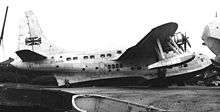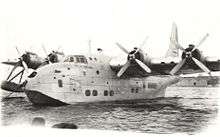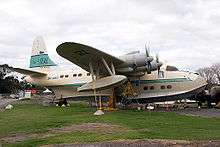Short Solent
| S.45A Solent | |
|---|---|
 | |
| The Aquila Airways Solent 3, G-AKNU, Sydney taking-off from Funchal | |
| Role | passenger flying boat |
| Manufacturer | Short Brothers and Harland |
| First flight | 11 November 1946 |
| Primary users | BOAC TEAL |
| Number built | 16 (and 7 converted S.45 Seafords) |
| Developed from | Short Seaford |
The Short Solent was a passenger flying boat produced by Short Brothers in the late 1940s. It was developed from the Short Seaford, itself a development of the Short Sunderland military flying boat design, which was too late to serve in World War II.
The first Solent flew in 1946. New Solents were used by BOAC and TEAL, production ending in 1949. Second-hand aircraft were operated until 1958 by a number of small airlines such as Aquila Airways.
Design and development
The Short S.45 Solent was a high-wing monoplane flying boat of aluminium construction. Power was provided by four Bristol Hercules[1] engines.
The aircraft could be fitted for 24 passengers with day and night accommodation or 36 day passengers. The cabins (four on the lower deck and two on the upper) could be used to sleep four or seat six. The upper deck included a lounge/dining area next to kitchen; the lower deck had two dressing rooms, toilets and three freight compartments. The flight crew was five (two pilots, navigator, and radio operator with the flight engineer in a separate compartment behind the flight deck opposite crew rest berths) and there were two stewards to attend to the passengers.[2]
Use

The Solent 2 introduced by BOAC could carry 34 passengers and 7 crew. Between 1948 and 1950, BOAC operated their Solents on the three-times weekly scheduled service from Southampton to Johannesburg taking a route down the Nile and across East Africa. The journey took four days, including overnight stops. The Solents replaced Avro Yorks running the service.[3] The last Solent-operated service on the route departed from Berth 50 at Southampton on 10 November 1950, bringing BOAC's flying-boat operations to an end.[4]
Tasman Empire Airways Limited (TEAL) operated a total of five Solent 4s between 1949 and 1960 on their scheduled routes between Sydney, Fiji and Auckland. The last TEAL Solent service was flown between Fiji and Tahiti on 14 September 1960 [4] by ZK-AMO "Aranui", which is now preserved. The TEAL Solents could carry 45 passengers and all versions of the type provided a great deal of space and luxury compared with contemporary or modern land-based aircraft.

Several Solents served Aquila Airways on their routes from Southampton to Madeira and the Canary Islands using ex BOAC and TEAL aircraft. On 15 November 1957, Aquila Airways G-AKNU, a Solent 3, crashed near Chessell, Isle of Wight, after it experienced loss of power to two engines.[5] The crash killed 45 out of the 58 on board. British commercial flying-boat operations ceased on 30 September 1958 when Aquila Airways withdrew its Madeira service.
Survivors
- Short Solent ZK-AMO Aranui, a Mk IV formerly used by TEAL firstly between Mechanics Bay on Auckland Harbour and Rose Bay Sydney Australia until superseded on scheduled services by the land based propliners. ZK-AMO was then redeployed on the iconic Coral Route, from Auckland New Zealand to Fiji, Samoa, Cook Islands, Tonga and Tahiti, until once again superseded by propliners in September 1960. ZK-AMO has been fully restored and preserved at the Museum of Transport and Technology in Auckland. Briefly overhauled outside when the Keith Park Memorial Aviation Display at MOTAT was enlarged 2010/2011.
- An ex-BOAC Solent 3, later owned by Howard Hughes, has been rescued and is in the United States at the Oakland Aviation Museum in Oakland, California.;[6] it is this Solent which appears briefly (and anachronistically) in the film Raiders of the Lost Ark, though through matte effects is made to resemble a more historically accurate Boeing 314 Clipper.[7]
Variants
- Solent 2
- civilian version for BOAC of the Short Seaford, 12 aircraft built at Rochester[8]
- Solent 3
- converted S.45 Seaford. 7 aircraft - 6 at Queen's Island, Belfast, 1 at Hamble[8]
- Solent 4
- powered by Bristol Hercules 733, four aircraft built at Belfast[8]
Operators

- Trans-Oceanic Airways
- South Pacific Airlines
The only military use of the Solent was for trials at the United Kingdom Marine Aircraft Experimental Establishment in 1951, the former BOAC Solent 3 was scrapped after the trials.
Specifications (Solent 2)
Data from Barnes and James[9]
General characteristics
- Crew: 7
- Capacity: 34 passengers
- Length: 87 ft 8 in (26.7 m)
- Wingspan: 112 ft 9 in (34.4 m)
- Height: 34 ft 3¼ in [10] (10.44 m)
- Wing area: 1,487 ft² (138.1 m²)
- Empty weight: 47,760 lb (21,664 kg)
- Loaded weight: 78,000 lb (35,381 kg)
- Powerplant: 4 × Bristol Hercules 637 radial piston engine, 1,690 hp (1,261 kW) each
Performance
- Maximum speed: 273 mph (237 knots, 439 km/h)
- Cruise speed: 244 mph[10] (212 knots, 393 km/h)
- Range: 1,800 miles (1,565 naut mi, 2,896 km)
- Service ceiling: 17,000 ft[10] (5,182 m)
- Rate of climb: 925 ft/min[10] (4.7 m/s)
References
- Notes
- ↑ National Archives Airworthiness Division Type Records
- ↑ Flight 3 January 1946 p10
- ↑ "To South Africa on the First Springbok Flying-boat Service" Flight 1948
- 1 2 Jackson 1988, p. 160
- ↑ Flight, 8 August 1958, p. 208
- ↑ Solent at the Oakland Aviation Museum, Oakland, California
- ↑ Verschuere, Gilles. "The Making of Raiders of the Lost Ark: Concluding the Adventure." The Raider.Net, 2009.
- 1 2 3 Barnes and James, pp. 407-409
- ↑ Barnes and James, p. 412
- 1 2 3 4 Jackson 1988, p.160.
- Bibliography
- Barnes, C.H.; James D.N. (1989). Shorts Aircraft since 1900. London: Putnam. ISBN 0-85177-819-4.
- Jackson, A.J (1988). British Civil Aircraft since 1919 Volume 3. London: Putnam. ISBN 0-85177-818-6.
External links
| Wikimedia Commons has media related to Short Solent. |